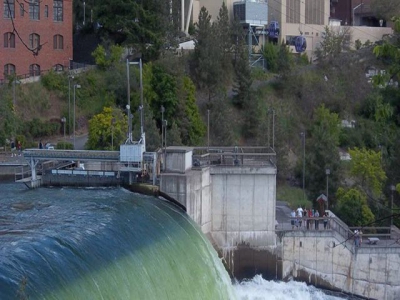Research to help water flow more freely to farms, fish, people

New technology and management approaches could help water flow more efficiently for farmers, residents and fish in the West.
Spokane Falls: Municipal communities, like Spokane, Wash., depend on water to thrive. A new $5 million grant project, led by researchers at Washington State University, helps water flow more efficiently to important uses. Photo: Dana Pride
New technology and management approaches could help the West’s water flow more efficiently for farmers, residents and fish, thanks to pioneering work by scientists at Washington State University (WSU).
“Water is a valuable resource for everything from food production to drinking water, recreation and a healthy ecosystem, but water doesn’t always flow to its most important and valuable uses,” said Jonathan Yoder, director of the State of Washington Water Research Center and professor in the WSU School of Economic Sciences.
Water is a challenging resource to manage for many reasons, including legal challenges for water rights, changing weather and uncertain supplies, difficulties in measuring consumption, gauging its value and role in natural systems and the costs and constraints of storing and moving it, WSU said.
Different crops and water uses, such as potatoes, tree fruit and irrigation for livestock pasture, have different values that can change seasonally or over time, affecting the demand for water, the university said in an announcement.
This summer, Yoder and a national, multidisciplinary team of researchers begin a five-year effort to smooth water’s flow, supported by a $5 million grant from the U.S. Department of Agriculture's Agriculture & Food Research Initiative’s Water for Food Production Systems Challenge Area.Their project, titled “Technology for trade: New tools and new rules for water use efficiency in agriculture and beyond,” includes researchers from five programs at WSU: State of Washington Water Research Center; Center for Sustaining Agriculture & Natural Resources; School of Economic Sciences; Department of Biological Systems Engineering, and Department of Civil & Environmental Engineering.
These programs will join forces with scientists at the University of Idaho, University of Washington, Kansas State University, University of Utah, Mammoth Trading, Aspect Consulting and a diverse group of water users and stakeholders.
WSU said the team will test new technology and practices that can help water flow to high-valued uses by improving information and opportunities to use water efficiently — ultimately helping farmers grow more with less water, and making more water available for people, fish and river flows.
“Our project will help find ways to improve water use efficiency in agriculture, by focusing on how technology, water rights and regulation work together to make the most of available water for all of its social and environmental values,” said Yoder, lead investigator for the project, and an affiliate with the Paul G. Allen School for Global Animal Health.
Testing new tech
“We’re developing three new technologies that will help improve water use efficiency across a wide range of uses,” he added.
The first, smart market technology, will facilitate water-rights transactions, making them work better, quicker and easier.
“Smart market technology could help water users more easily trade water with less impact on stream flows and fellow water users,” Yoder said.
Another new technology, seasonal forecasting of water availability, crop water demands and crop productivity, could provide more precise and timely information to support water market decisions.
“Water availability in the West is highly variable and uncertain,” Yoder said. “Better seasonal forecasting of water availability and water demand can be really valuable for supporting efficient water use, water markets and water regulation.”
Finally, researchers will pilot a satellite-based automated monitoring technique called METRIC in Washington state.
Short for “Mapping EvapoTranspiration at high Resolution and Internalized Calibration,” this technique uses satellite imagery to measure water consumption by agriculture or other water consumers. With the grant, researchers will help perfect this system, giving water resource managers a clearer picture of agricultural water use, and ultimately, residential use as well, WSU said.
The technologies examined in the project will be tested in three regions of the Columbia River basin — the Yakima, Okanogan and Walla Walla watersheds.
Along with new technology, the project will identify promising changes in law, legislative and administrative rules, contracts and norms to promote water efficiencies.
“New technologies like the ones we are focusing on may hold the keys to modernizing water rights in the long run, so that water can be better allocated across the Northwest’s many competing uses,” Yoder said.
Related news
 Tra fish shipments give hope to aquatic product exports
Tra fish shipments give hope to aquatic product exports Tra fish (pangasius) exports are likely to surpass 2 billion USD for the first time this year, presenting an opportunity for Vietnam’s aquatic product exports
 Aquatic product exports fetch 5.5 billion USD in 8 months
Aquatic product exports fetch 5.5 billion USD in 8 months Export revenue of aquatic products in August hit 739 million USD, pushing total earnings in the first eight months of 2018 to 5.5 billion USD
 Global Aquaculture Innovation Award finalist: Osmo Systems
Global Aquaculture Innovation Award finalist: Osmo Systems Silicon Valley startup eyes U.S., Ecuador markets for water quality sensor ‘Osmobot’